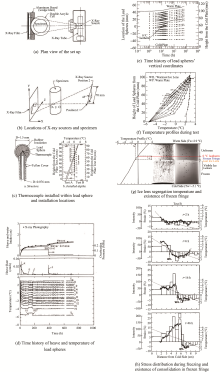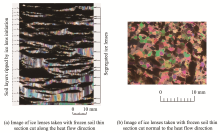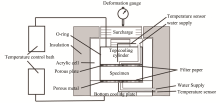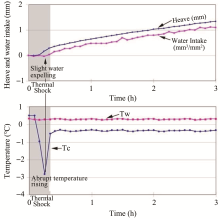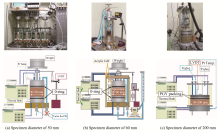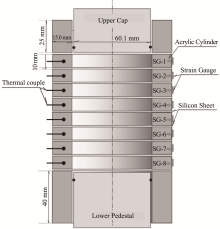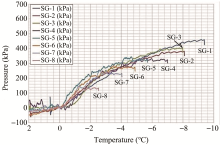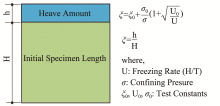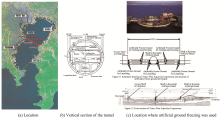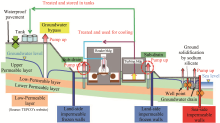|
Akagawa S, 1988. Experimental study of frozen fringe characteristics. Journal of Cold Regions Science and Technology, 15: 209-223.
|
|
Akagawa S, 1990. X-ray photography method for experimental studies of the frozen fringe characteristics of freezing soil. U.S.A. CRREL Special Report 90-5.
|
|
Akagawa S, 1997. Winter Earthworks in Seasonal Freezing Regions Ought to Become an Accepted Construction Method—Frost heaving accelerates the consolidation of filling materials. Proc. Eighth International Symposium on Ground Freezing, Lukea, Sweden: 65-72.
|
|
Akagawa S, 2016. Phenomena of frost heaving and engineering difficulties caused by frost heaving. International Cold Regions Oil & Gas Seminar, Sole: 143-168.
|
|
Akagawa S, Goto S, Saito A, 1988. Segregation freezing observed in welded tuff by open system frost heave test. Proc. Fifth International Conference on Permafrost. Trondheim, Norway: 1030-1035.
|
|
Akagawa S, Yamamoto Y, Hashimoto S, 1985. Frost heave characteristics and scale effect of stationary frost heave. Proc. Fourth International Symposium on Ground Freezing. Sapporo, Japan: 137-143.
|
|
Amanuma C, Kanauchi T, Akagawa S, et al., 2017. Evaluation of frost heave pressure characteristics in transverse direction to heat flow. Procedia Engineering, 171: 461-468.
|
|
Beskow, 1935. Soil Freezing and Frost Heaving with Special Applications to Roads and Railroads. The Swedish Geological Society. (Translated by Osterberg JO.). Technological Institute, Northwestern University.
|
|
Black PB, Hardenberg MJ, 1991. Historical perspective of frost heave research. CRREL Special Report: 91-23.
|
|
Chamberlain EJ, 1981. Frost susceptibility of soil—Review of index tests. CRREL Monograph 81-2.
|
|
Chamberlain EJ, Gow AJ, 1978. Effect of freezing and thawing on the permeability and structure of soils. First International Symposium on Ground Freezing, Ruhr-Univ., Bochum, West Germany, 31-44.
|
|
Goto S, Ryokai K, 1980. Frost action of the soil surrounding a LNG inground storage tank, Second International Symposium on Ground Freezing, Trondheim, Norway: 1049-1059.
|
|
Goto S, Watanabe O, Igro M, et al., 1985. The measurement of frost heaving pressure on an LNGinground tank. Fourth International Symposium on Ground Freezing, Sapporo, Japan: 337-341.
|
|
Japanese Geotechnical Society, 2009. Test Method for Frost Heave Prediction of Soils (JGS 0171-2009). URL:.
|
|
Johansson S, 1914. Die Festigkeit der Bodenarten bei verschiedenem Wassergehalt. S.G.U.,Ser. C,no. 256: 145. in Osterberg JO's English translation (1947) of Beskow (1935).
|
|
Miyata Y, Minami Y, Akagawa S, 1994. Measuring unfrozen pore water pressure at the ice-lens forming front. Proc. Seventh International Symposium on Ground Freezing, Noncy, France: 157-162.
|
|
Penner E, 1961. Ice-grain structure and crystal orientation in an ice lens from Leda Clay, GSA Bulletin, 72(10): 1575-1577.
|
|
Runeberg EO, 1765. Anma¨rkningar om na¨gre fo¨ra¨indringar pa¨ jord-ytan i alima¨nhet, och under de kalla Climatisynnierhet. KunglicaVerensk, Akademiens Handlingar, 81-115.
|
|
Taber SM, 1929. Frost heaving. The Journal of Geology, 37: 428-461.
|
|
Taber SM, 1930. The mechanics of frost heaving. Samma Tidskrift, 38: 303-317.
|
|
Takagi S, 1979. Segregation freezing as the cause of suction force for ice lens formation, Engineering Geology, 13: 93-100.
|
|
Takashi T, Yamamoto H, Ohrai T, et al., 1978. Effect of penetration rate of freezing and confining stress on the frost heave ratio of soil. Third International Conference on Permafrost, Ottawa, Canada: 736-742.
|




